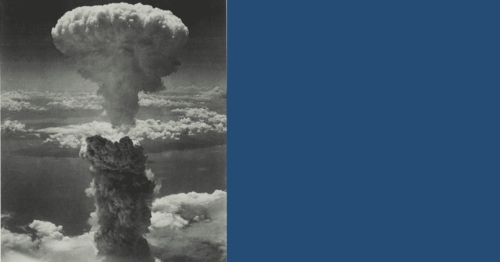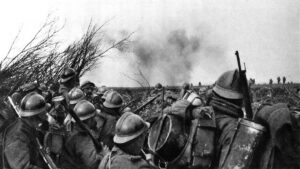
Documents and Debates: The Decision to Use the Atomic Bomb
On July 16, 1945, the USS Indianapolis slipped away from its moorings on Mare Island, California, headed for the South Pacific. The United States military command so heavily guarded the ship’s mission that not even its Captain, Charles B McVay, III, knew its true nature. Ten days later, the Indianapolis arrived at Tinian Island in the Northern Marianas. The crew unloaded its precious cargo – half the world’s supply of U-235 and all the components necessary to build an atomic bomb. The bomb, nicknamed Little Boy, was assembled on Tinian, loaded onto a bomber named the Enola Gay, and dropped on Hiroshima, Japan, August 6, 1945. The blast immediately killed 80,000 people. Three days later – August 9 – a second bomb devastated Nagasaki, Japan. Pressed by a naval blockade of the home islands, the USSR’s entry into the war against Japan, and the atomic catastrophe’s impact, Japan surrendered on August 14, 1945. The war was over.
Peace came too late for nearly 900 members of the USS Indianapolis’s crew. After delivering the bomb, the ship patrolled the waters near Guam then struck out for the Philippine Islands. On the night of July 30, 1945, a mere four days after dropping its cargo on Tinian, a Japanese submarine put two torpedoes into the ship’s hull, killing 300 crew members instantly – the rest went into the water. A series of wartime snafus prevented word from reaching potential rescuers that the Indianapolis was missing. For three-and-a-half days, survivors trod water, dying from dehydration, saltwater poisoning, and sharks. Only 316 survived – the largest single-ship naval disaster in United States history.
Nearly everything connected to this first wartime use of an atomic bomb seems stranger than fiction – from the weapon’s development to the Indianapolis’s horrific fate. The Indianapolis was in California to repair damage caused by a kamikaze attack of Okinawa in March of 1945, making it the right candidate to deliver the bomb. At its height, the Manhattan Project, the development effort that created the bomb, employed 125,000 workers, spread across the country from Oak Ridge, Tennessee, to Chicago, Illinois, and Los Alamos, New Mexico. The project cost $2B, a staggering sum in the 1940s. It was so secret, even Vice-President of the United States Harry S. Truman was unaware of its existence when he was sworn in as President following Franklin Roosevelt’s death in April of 1945.
Truman had to get up to speed quickly. He met with other Allied leaders in Potsdam three months after becoming President. While at the conference, scientists in New Mexico successfully tested a live bomb, then notified Truman, who informed USSR premier Joseph Stalin. Truman confided to his diary that the news didn’t seem to surprise Stalin. We now know that Stalin knew about the American progress because he had spies at Los Alamos. Now Truman faced one of the most consequential decisions in American presidential history. Should this new weapon, with its tremendous destructive power, be used in hopes of shortening the war with Japan?
Truman sought advice before making the decision from an Interim Committee, composed of scientists and military leaders, charged with considering the moral, political, and military implications of using the bomb. The Interim Committee recommended to Secretary of War Henry Stimson on June 21 “that the weapon be used against Japan at the earliest opportunity, that it be used without warning, and that it be used on a dual target, namely, a military installation or war plant surrounded by or adjacent to homes or other buildings most susceptible to damage.” (Document A)
The military alternative to using the bomb was an invasion of Japan’s main islands, similar to the D-Day invasion of France in June of 1944. General Douglas MacArthur, Supreme Allied Commander in Asia, told Truman that “sooner or later a decisive ground attack must be made.” Casualty predictions for the planned invasion horrified the new President. Truman went to his grave, insisting that using the atomic bomb, deadly as it was, saved more American and Japanese lives than it cost. (Document B)
The documents in Teaching American History’s Volume II, Chapter 23: The Decision to Use the Atomic Bomb set Truman’s decision in the context of the protracted Pacific War and capture much of the reasoning behind it. Reading the documents, students become vicarious decision-makers critiquing the thinking of critical scientific, military, and political leaders as they consider whether to use the most destructive weapon the world has ever known to end earth’s most catastrophic war.
Documents in this chapter include:
A. The Scientific Panel of the Interim Committee, Recommendations on the Immediate Use of Nuclear Weapons, June 16, 1945
B. Minutes of Meetings held at the White House on Monday, June 18, 1945
C. Proclamation Defining Terms for Japanese Surrender, Potsdam, July 26, 1945
D. President Harry S. Truman, Press Release Alerting the Nation About the Atomic Bomb, August 6, 1945
E. J. R. Oppenheimer to Secretary of War Henry Stimson, August 17, 1945
We have also provided audio recordings of the chapter’s Introduction, Documents, and Study Questions. You’ll find these just beneath the headings for each element of the chapter. These recordings support literacy development for struggling readers and the comprehension of challenging text for all students.
Teaching American History: We the Teachers blog will feature chapters from our two-volume Documents and Debates in American History with their accompanying audio recordings each month until recordings of all 29 chapters are complete. Following today’s post on Volume II, Chapter 23, we turn, on March 9th, to Volume I, Chapter 10: The Market Revolution and (The Myth Of) Free Labor. We invite you to continue following this blog closely, so you will be able to take advantage of the new audio feature as the recordings become available.



